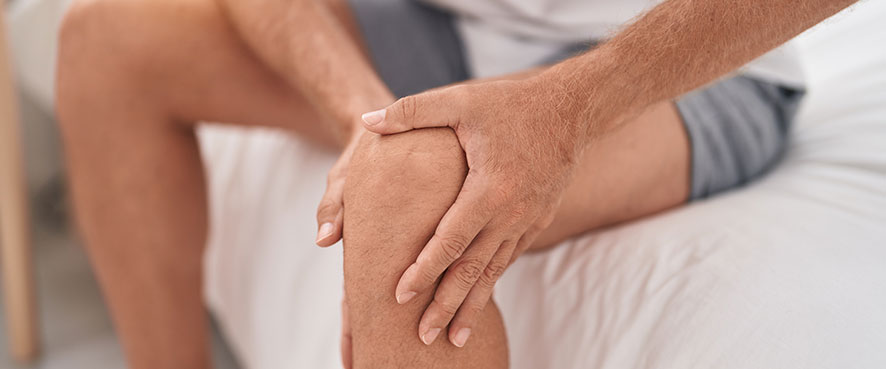The meniscus is a structure in the knee joint that you can think of as a kind of cushion that reduces friction and provides compatibility. It is located in the knee joint between the upper leg bone (femur) and the lower leg bone (tibia). These structures allow the knee to move and also provide protection to the knee joint by absorbing impact.
Each knee has two menisci, one on the inner side and one on the outer side, both shaped like a “C”. They help maintain balance during movement of the knee joint and protect the joint surfaces.
Causes of Meniscus Injuries
Meniscus injuries typically arise from sudden or repetitive trauma to the knee joint. For instance:
- Sports Injuries: Meniscus injuries may occur during activities such as sudden turning, twisting or falling, especially in sports such as soccer, basketball, tennis, skiing, volleyball.
- Over-Bending: Excessive bending of the knee, especially during weightlifting or gravity-defying exercises, may lead to meniscus damage.
- Falling On the Knee: Falling on the knee or impact with a hard surface can result in meniscus tears.
- Aging: During aging, the meniscus tissue may weaken and degenerate, increasing the likelihood of tears.
- Repetitive Stress: Prolonged repetitive stress or overuse can strain and wear down the meniscus. Occupations or activities that place excessive stress on the knee are particularly contributory.
- Abnormal Shapes and Positions Between the Bones: Abnormal shapes or positions between the bones in the knee joint can put the meniscus under abnormal pressure and lead to injury.
Although meniscus injuries are often associated with specific traumatic events or activities, sometimes the exact cause of injury may not be clear. Particularly in old age, degenerative changes and chronic loading may also result in meniscus injuries.
Symptoms of Meniscus Injuries
Symptoms of meniscus injuries may vary among individuals and differ depending on the severity of the injury. However, the following symptoms are commonly associated with a meniscus injury:
- Knee Pain: After a knee injury, you may feel aching, stinging or inflammation in your knee. This pain may intensify in the area of the injury, usually on the inside of the knee or on the side of the knee. It may increase, especially when bending and straightening the knee or putting a load on it. Over time, the pain may worsen and make it difficult to move.
- Swollen Knee: After a meniscus injury, swelling may develop in the knee. Swelling is usually noticeable immediately after the injury or within a few hours. This swelling in the knee may make your knee feel fuller and may be firmer than usual when you touch it.
- Locking or Tripping Sensation: With a knee injury, you may experience a kind of tripping, blocking or locking sensation in your knee. This may be especially noticeable when you bend your knee completely and try to straighten it.
- Clicking or Popping Noises: After an injury to your knee, you may hear an internal crunching or popping sound when you move or bend your knee. These sounds may be caused by parts of the injured meniscus sliding or shifting inside the joint. These sounds may increase or decrease over time, depending on the severity of the injury.
- Restriction of Knee Movement: After a meniscus injury, it may be more difficult to fully bend and straighten your knee. In particular, you may find it difficult to bend your knee completely and sit or stand up, climb or descend stairs. This limitation of movement is usually caused by the injured meniscus interfering with normal movement.
If you experience any one or more of these symptoms, you may think you have a problem with your knee. In this case, it is important to contact a doctor or specialist to assess the situation. The specialist will perform a physical examination and, if necessary, imaging tests to determine the best treatment for you.
Treatment of Meniscus Injuries: Surgical and Non-Surgical Options
The treatment of meniscus injuries varies depending on the type, size, age of the patient, physical condition, and severity of symptoms. While small or moderate meniscus injuries can often be treated with non-surgical methods, in some cases, surgery may be necessary.
Surgical treatment is generally recommended in the following situations:
Large Tears: If the meniscus tear is large or completely torn, surgical intervention may be necessary.
Severe Injuries: In cases of meniscus injuries following severe trauma or when other structures in the joint are also damaged, surgical intervention may be required.
Young and Active Patients: Meniscus repair may be preferred in young and active individuals. This helps better preserve the joint and reduce the risk of early osteoarthritis.
Locking or Limitation of Movement in the Knee: If there is a sensation of locking or limitation of movement in the knee, and this condition is not responsive to conservative treatments, surgical correction may be needed.
Meniscus surgery is typically performed using arthroscopic methods. This involves inserting a camera and surgical instruments into the knee through small incisions. This minimally invasive approach can reduce recovery time and lower the risk of complications.
However, not all meniscus injuries require surgery. Small tears and mild symptoms can often be managed with conservative treatments (rest, physical therapy, medications, etc.). The treatment plan is determined based on the individual’s condition and the characteristics of the injury. Therefore, it is important to consult with an orthopedic surgeon or specialist if there is suspicion of a meniscus injury. The specialist will assess the patient’s condition and determine the most appropriate treatment options.
Non-surgical treatment options may include:
Rest: Resting the injured knee can support the healing process. Avoiding excessive activity is important to allow the injured meniscus to heal.
Ice Application: Regularly applying ice at regular intervals can help reduce swelling in the knee. Ice can also alleviate pain and control swelling. However, it is important to be careful not to apply ice directly to the skin and not to exceed the application duration.
Compression: You can wrap your knee with a knee brace or elastic bandage to reduce swelling and provide support to the knee.
Elevation: Elevating your knee above heart level after a knee injury can help reduce swelling. This can accelerate the healing process by increasing blood flow.
Physical Therapy: Exercises and physical therapy programs conducted under the guidance of a physiotherapist can strengthen knee muscles, improve flexibility, and stabilize the knee. Your physiotherapist will customize exercises and therapies specifically for you.
Medications: With your doctor’s recommendation, you can take prescription or non-prescription medications to control pain and inflammation. This may include pain relievers, nonsteroidal anti-inflammatory drugs (NSAIDs), or steroid injections.
Collagen or Glucosamine-Chondroitin Supplements: Some individuals may prefer to use collagen or glucosamine-chondroitin supplements to support joint health. However, while there is no definitive evidence of the effectiveness of these supplements, they may help reduce complaints in suitable patients; so it is important to consult with your doctor before use.
The effectiveness of these treatment options may vary depending on the type, severity of the injury, and the patient’s overall health. If there is suspicion of a meniscus injury, it is recommended to consult with an orthopedic specialist or doctor and undergo necessary examination and imaging tests. A correct diagnosis will help determine appropriate treatment options.




